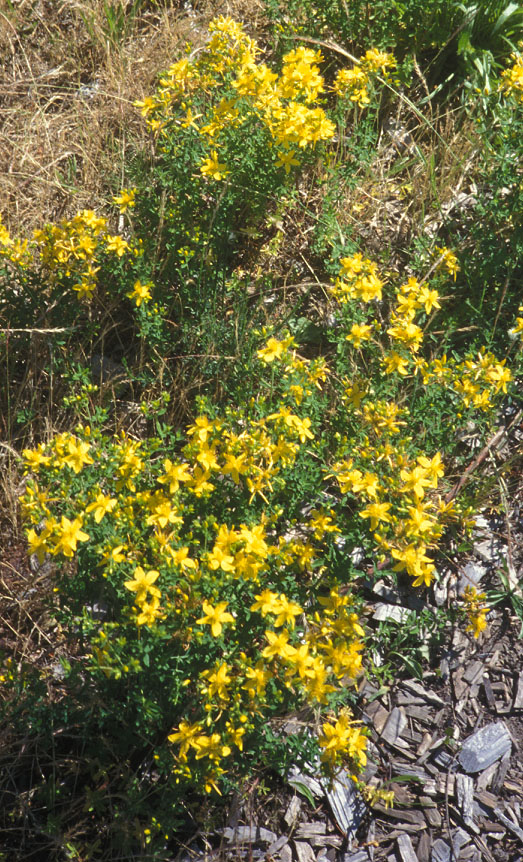
|
| Saint John's-wort; Hypericum perforatum L. |
Saint John's-wort Family; GUTTIFERÆ (CLUSIACEÆ or HYPERICACEÆ)
|
| With such an illustrious namesake as St. John the Baptist, this weed might be expected to be something special. To merely look at
it you wouldn't know it, but it is special, indeed. The species is native in Europe, and was called Hyperikon by the ancient
Greeks, derived from hyper, above, and
icon, a picture, as the plant was placed
above pictures to retard evil spirits. Then
Christianity's burgeoning influence somehow focused on an association with St. John, which is documented from the 6th century onwards,
although why is unknown. |
| For both real and imagined reasons, the plant has been esteemed for its spiritually-protective properties and
bodily-healing abilities. It was ceremonially burned in pre-Christian midsummer eve bonfires to encourage the sun to delay its waning; and the list
of St. John's-wort's curative properties is impressive in length and content. Even today, it is one of very few plants being seriously
tested as an anti-viral drug to combat the HIV disease. |
| Although many species of Hypericum exist, and several are prized garden ornamentals, only the original St. John's-wort
(H. perforatum), is commonly found weedy and wild in our area. Don't confuse it with Garden St. John's-wort
(H. calycinum), also known as Aaron's Beard. The latter has comparatively huge leaves and flowers, and is a groundcover. |
| Wild St. John's-wort consists of a strong clump of stiffly upright, narrow stems, branching near their tops in a
geometrically pleasing and orderly fashion, surmounted by dozens of dime-sized bright yellow flowers from June into August. Later, the
dark reddish-brown seed capsules rustle when passers-by or wind, scatter the tiny seeds. Pluck one of the leaves, hold it to the sky,
and you'll see glandular dots perforating its surface, which is why the plant was named
H. perforatum. |
| The weed grows in sunny vacant lots, roadsides, and meadow environments. It dislikes shade but tolerates some
after becoming established. There are dry, sunny stretches of country roadsides in July quite yellow with it, and its
yellow-flowered associates tansy, tansy ragwort, and goldenrod. Depending on its circumstances, it will be knee-high to 4 or 5 feet tall, every
year making a larger clump. It is deep-rooted, drought tolerant and long lived. |
| It is not a problem weed in gardens. But it is phytotoxic, which means albino livestock may get poisoned by eating it,
and persons with fair skin should avoid handling it, especially when they are sweating on sunny days. |
Other names are Balm of Warrior's Wound (from its use as "a most precious remedy in treating deep wounds"),
Klamath Weed (originally applied in California's Humbolt County), Goatweed (the young shoots prized food). In the Language of Flowers
it not surprisingly signifies superstition, and for some reason, animosity. Although St. John's feast day is June 24th, the anniversary
of his beheading is celebrated August 29th, and on that day the plant is said to have red spots, symbolizing the martyr's blood.
|
Originally published as the Seattle Tilth newsletter Weed of the Month in July 1993, along with an illustration from a book.
Back |
|
|

